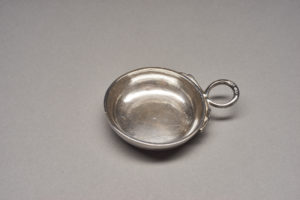The McClung plays a big role in the UT experience for many members of our campus community. To highlight these connections, we asked UT faculty and staff to tell us about an object in our collection that has impacted their classes, their students, or their own exploration within the museum.
 Many faculty members work with the McClung’s Academic Programs team to bring objects that are not on view out of collection storage for their students. These objects are carefully chosen to compliment and enhance the lessons from the class. Hilary Havens, Assistant Professor with the Department of English, comments on one of her favorite objects–the eighteenth-century wine taster from Angers, France pictured here.
Many faculty members work with the McClung’s Academic Programs team to bring objects that are not on view out of collection storage for their students. These objects are carefully chosen to compliment and enhance the lessons from the class. Hilary Havens, Assistant Professor with the Department of English, comments on one of her favorite objects–the eighteenth-century wine taster from Angers, France pictured here.
“I generally visit the museum with my eighteenth-century literature or British culture classes,” Havens states. “We read texts that highlight differences between social classes. I often pair it with a fancy silver cup in our museum visits, and I have students try to guess what the taster is. No one gets it right, but once you know the taster’s purpose and that it is intended for servants to utilize, the features–like the poor quality silver, small size, and lack of ornamentation–make sense.”
A wine taster, or tastevin, is a small, shallow bowl with a simple ring handle. It traditionally would have been worn on a cord around the neck like a necklace. Tasters were originally developed by cellarmasters or winemakers in Burgundy, France. The shape of the bowl allows for it to catch light even in the dark wine cellars, making inspecting wine for color and clarity much easier. This allowed the winemaker to ensure that they were providing a quality beverage for their consumer.
Wine tasters were used for a more harrowing reason, too. Also in France, a servant, called a sommelier, would often be asked to taste wine–and food–in front of and before it was consumed by their liege. This taste test not only ensured that the food and drink would be of a suitable quality, but it also made sure that there was no poison. If the sommelier did not die after a sip of wine from their taster, than the aristocrats assumed that there was no pending assassination attempt. Today, we still have sommeliers, but the job is much different (sort of).
This particular wine taster is engraved with “I. Touchais,” which was most likely the original winemaker’s name. Today there is a vineyard in the Loire valley of France owned by the Touchais family that dates back to 1787. The object was most likely owned by one of their ancestors.
Haven’s object lesson is a great example of one way that the McClung benefits UT students through experiential learning. Comparing the wine taster, which was created for a servant’s drink, to the silver cup, which was made for an aristocrat’s drink, brings literature from the past to life. European class divides are illustrated through in a tangible, memorable way. Plus, students can see how subtle the details from any object can provide clues to how, and by whom, its use was intended.
Additional Resources:
Lukacs, Paul. Inventing Wine: A New History of One of the World’s Most Ancient Pleasures. W. W. Norton & Company (2013)
